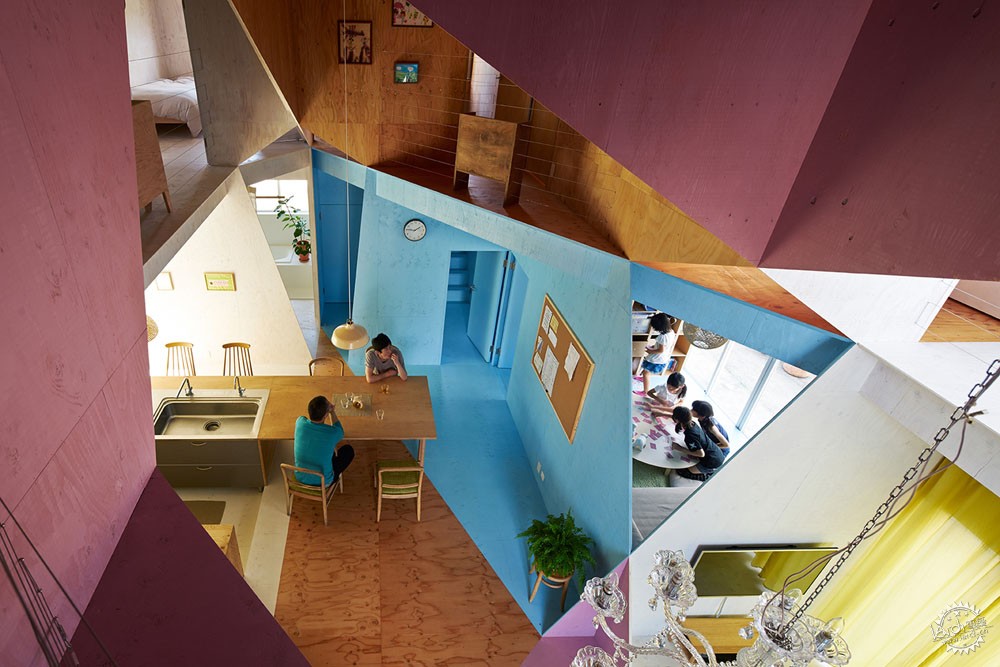
由专筑网张可娜,刘庆新编译
来自事务所的描述。该项目是一个位于东京郊区的独立家庭住宅的改造工程,原建筑是一幢有八个出租单元的典型的两层公寓楼。而旧公寓里有超过一半的单元是闲置的,业主本想拆除它,然后重新建立一个新的单户家庭(父母和2个女孩)。然而,根据他们的预算,我提出了将现有建筑改造为一个家庭住房,而不是将其拆除。而且我认为客户如果重新建造一幢住房,将只能获得原有面积的一半,这对他们没有益处。
From the architect. This is a renovation project of single-family house, originally used as a typical two-story apartment-house with eight small rental units in the suburban area of Tokyo, Japan. More than half of the units of this old wooden apartment were empty, therefore the owner wanted to demolish it and then build a new single-family house (parents and two girls) at the beginning. However, I proposed to renovate this existing building into a single-family house instead of demolishing it, because with their budget I thought the clients could only gain the half area of the existing building if they built a new one, which does not benefit them.
Courtesy of Kazuyasu Kochi
Section/剖面图
日本的人口减少是从十年前开始的,住户数量也随之减少。从理论上讲,因此人们可以在他们的住宅里拥有更多的空间。日本人在小房子里的生活方式已经改变了。以前为了满足更多人而将有限空间划分为多个小空间,而现在是将将现有空间联结在一起为少数人服务。然而,我认为大部分家庭仍然希望将住宅分割为许多房间。我描绘了一个新住宅的形象,它很好得平衡了分割空间和联合空间之间的关系,使分割的小空间和联合的大空间在此共生。这样做的结果是形成了动态、复杂的内部空间,这提供了生活所有活动所需的功能空间,而非单一空间。该项目被称为“Apartment-House”,我的目的是在这个小建筑内创造多样化的景观和丰富的高密度。
Depopulation in Japan started 10 years ago. The number of householders decreased, too. I would say theoretically people can have more space in their residences. The time of Japanese people living in tiny houses has changed. There is a shift from dividing limited space for many people into uniting existing divided space for fewer people, I think. However, clients generally still tend to divide a house into many rooms. I picture the image of a new house, which is well-balanced between dividing and uniting space inside. The act of dividing coexists with the act of uniting here. The result will be dynamic and complex internal space, which provides the experience of being all the spaces without losing the sense of retreating into the one. In this project called ‘Apartment-House’, my ambition is to create high density and richness of diverse sceneries in this small architecture.
Courtesy of Kazuyasu Kochi
开始,我在公寓里挖了一个洞,把八个房间连接起来。现有的建筑物具有由墙壁和地板构成的刚性的三维网格,其中系统地划分为八个内部空间。我把二维形状(三角形或四边形,而不是五边形)从这个网格系统中分割出来。以此为原则,我决定这些二维形状不应该再遵循三维网络。例如,一个三角形的形状被切断穿过一层和二层之间的网格,并放置在一个平面和坐标平面之外。八个房间的每一个都在三维网格中形成,与二维形状无关。我用称之为“四色定理”的四种不同的生动颜色,定义每个二维形状,以强调存在,而没有遵循网格结构。正如我们的视角,可以在同一空间内找到不同类型的深度,就像是透视图一样。
I started with cutting a hole inside the apartment to connect eight rooms. The existing building has rigid 3D grid, consisting of the walls and floors, which systematically divide the internal space into eight. I cut 2D shapes (triangle or quadrangle, not pentagon) out from this grid system. As a rule, I decided these 2D shapes should not follow the 3D grid. For example, one triangle shape was cut out crossing the grid between the first floor and the second, and placed beyond the X and Y coordinate plane. Each of the eight rooms is on the 3D grid, but 2D shapes are not. I used different vivid colors as “Four color theorem” for each 2D shape, which is not following the grid, to emphasize the presence. As we stand inside, we can find two different types of depth ( =perspective view) in the same space.
Floor Plan/平面图
Courtesy of Kazuyasu Kochi
这种设计展示出了空间的不同深度,这让我想起一幅立体派画作,具有2D和3D之间的透视失真。我们可以看到的风景,在三角形和四边形聚集、重叠、彼此相交,创造多样性的空间。
The result of this process showed some different depth of space, which reminded me of a picture of Cubism, which has distortion of perspective between 2D and 3D. We can see scenery, in which triangles and quadrangles gathered, overlapped and intersecting each other, creating diversity of spaces into one place.
Before/改造前。Image Courtesy of Kazuyasu Kochi
© Daici Ano
建筑不能脱离三维网格系统,绘画也不能从二维中逃脱出来到另一方面。但在艺术史上,立体派却在2D画中找到了一个新兴的空间深度。同样,是否可以在三维空间中发现其新兴的深度?
Architecture cannot escape from 3D grid system, and paintings also cannot escape from 2D on the other hand. In the history of art, cubist found an emerging depth of space in their 2D paintings. Similarly, may architecture discover its emerging depth in the 3D space?
Courtesy of Kazuyasu Kochi
© Daici Ano
© Daici Ano
Drawing Proccess/绘图过程
Floor Plan/平面图
建筑设计:Kochi Architect's Studio
项目位置:日本
主建筑师: Kazuyasu Kochi
建筑面积:177.0 平方米
项目时间:2014年
建筑摄影:Daichi Ano, Courtesy of Kazuyasu Kochi
结构工程:Yukihiro Kato / MI+D architectural laboratory
施工团队:SUGIMOTO GROUP
用地面积:198.35平方米
Architects: Kochi Architect's Studio
Location: Chiba, Chiba Prefecture, Japan
Architect in Charge: Kazuyasu Kochi
Area: 177.0 sqm
Project Year: 2014
Photographs: Daichi Ano, Courtesy of Kazuyasu Kochi
Structural Engineering: Yukihiro Kato / MI+D architectural laboratory
Construction: SUGIMOTO GROUP
Site Area: 198.35m2
出处:本文译自www.archdaily.com/,转载请注明出处。
|
|
